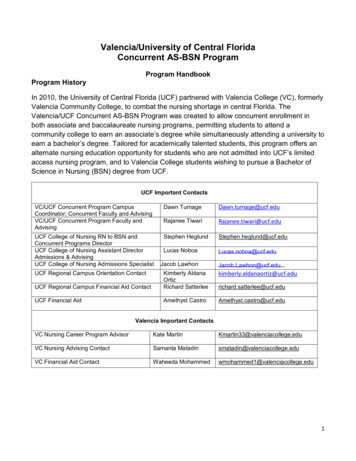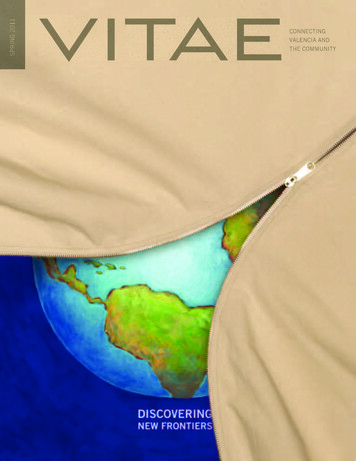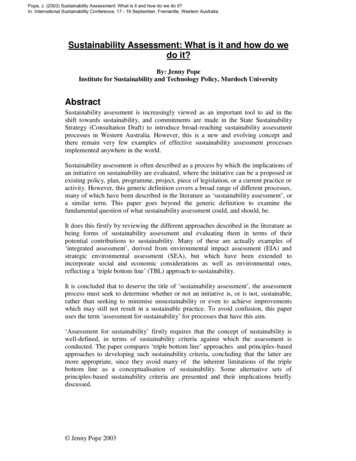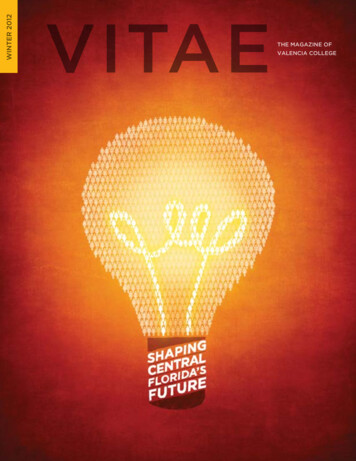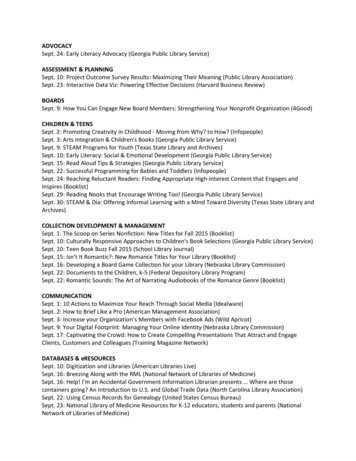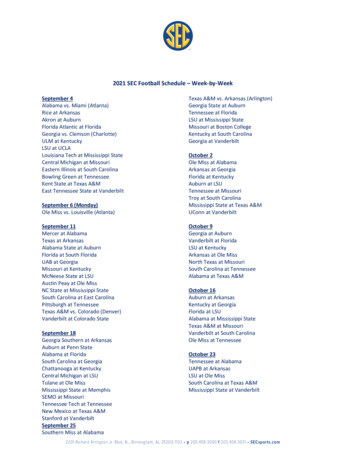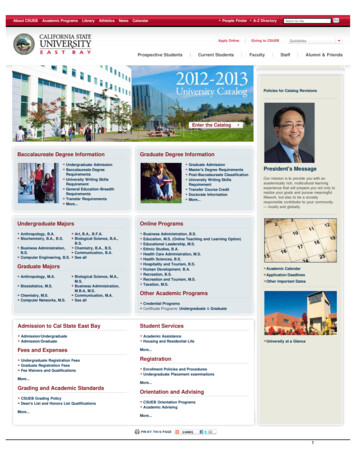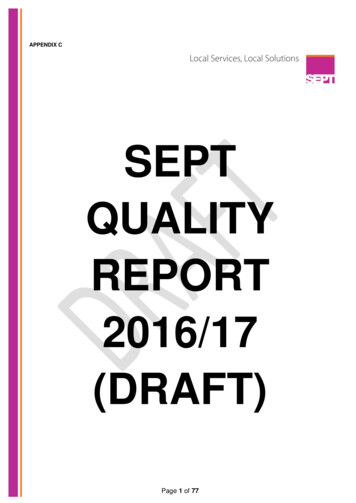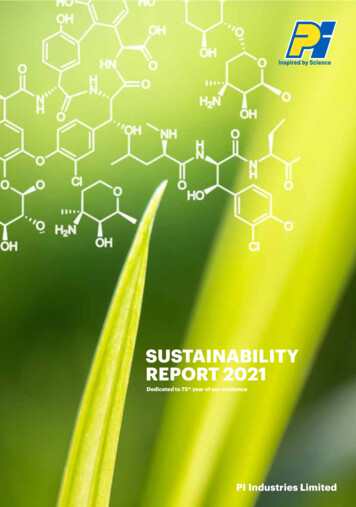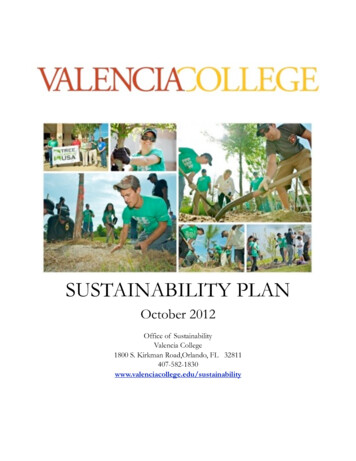
Transcription
SUSTAINABILITY PLANOctober 2012Office of SustainabilityValencia College1800 S. Kirkman Road,Orlando, FL ility
INTRODUCTION 3OUR PROFILE 3Valencia College’s Six Campuses 3Our Participation 3OUR PLANNING TOOLS 4American College & University President’s Climate Commitment (ACUPCC) 4The Triple Bottom Line 5Sustainability Tracking & Rating System (STARS) 6Clean Air Cool Planet and USGBC 6OUR SUSTAINABILITY PROGRESS 6Sustainability Committee 6Office of Sustainability 7Baseline Reports (See also Appendices) 7Greenhouse Gas Inventory (2010) 7Climate Action Plan (2010) 7Sustainability Tracking & Rating System (STARS) (2012) 7GOALS AND STRATEGIES 8ACUPCC Actions 8Climate Action Plan (CAP) Mitigation Strategies 9Follow up on CAP Goals:TRANSPORTATION 9BUILDING ENERGY 13EDUCATION AND OUTREACH 16SOLID WASTE 20WATER EFFICIENCY 21GROUNDS 22CAMPUS AS A LIVING LABORATORY 23FINANCING 23APPENDICESAPPENDIX 1-OUR SUSTAINABILITY PROGRESS: YEAR BY YEAR ACCOMPLISHMENTSAPPENDIX 2 - GREENHOUSE GAS INVENTORY (This is an excerpt of the 2010 document covering 2006-8.Complete document is posted as a separate PDF)APPENDIX 3 - SUSTAINABILITY ACROSS THE CURRICULUMADDITIONAL DOCUMENTSCLIMATE ACTION PLAN (2010) (Complete document is posted as a separate PDF)Valencia College Sustainability Plan 2012 -2valenciacollege.edu/sustainability
INTRODUCTIONSustainability is described as meeting the needs of the present without compromising the ability of future generations tomeet their own needs (1987, Gro Harlem Brundtland in a report by the World Commission on our Environment andDevelopment).As an educational institution, Valencia College is aware of its unique position not only to provide by example but to act as aleader for future generations.Sustainability is not a new concept for Valencia College. The Facilities Department has implemented many sustainabilityinitiatives, including energy efficiency projects, a green building policy for all new buildings, and has replaced traditionalcleaning products with green cleaning products.Valencia College is committed to reducing its carbon footprint while also planning for future growth and development.We wish to systematically incorporate sustainable practices and decision processes throughout both operations and theacademic curriculum and to serve as a catalyst for awareness and education throughout the College community.This Sustainability Plan focuses on activities, practices, and processes which directly and indirectly impact campusgreenhouse gas emissions.Operations - buildings, transportation, waste management, dining services, energy, purchasing, groundsEducation – curriculum, co-curricular education, and faculty/staff development and trainingAdministration & Finance – sustainability infrastructure, investment, and planningCommunity Relations & Partnerships – student outreach and community partnershipsThe Sustainability Plan reviews commitments and strategies previously suggested and prioritizes them, based on our currentstaffing, budgets, and areas of emphasis.OUR PROFILEIn fall of 1967 Valencia Junior College opened in a few portables on West Oak Ridge Road in Orlando. In 1971, we movedto our first permanent location on what has become West Campus and the name was changed to Valencia CommunityCollege. In 2011, we changed our name to Valencia College.Valencia College is the second largest 2-year college in Florida, after Miami-Dade College. Over 40,000 students attendclasses each year (Fall 2011 42,987 on all campuses).There is no typical Valencia College student. Students differ considerably in ethnic, social, and economic backgrounds andtheir educational goals. Most students reside in the Orange, Osceola, or Seminole Counties. Our campus does not operateresidential housing and is essentially a commuter campus. Students typically work full or part time and attend college on apart time basis.The college offers a two-year A.A. parallel program that prepares students to transfer to an upper-division college oruniversity; college-preparatory courses that help first-year students excel; and technical (A.S.) programs and continuingeducation courses that prepare students to meet the needs of business and industry.The University of Central Florida (UCF) operates joint buildings with Valencia College on two campuses (West andOsceola), and offers 15 UCF undergraduate degrees. Valencia offers two bachelor's programs: Radiologic and ImagingSciences and Electrical and Computer Engineering Technology.Valencia College was ranked the top community college in the nation for 2011-2012 by the Aspen Institute, a Washingtoneducational and policy studies center. Aspen chose Valencia as the inaugural winner based on the strength of its graduationand transfer rates, especially among minority students, as well as its workforce training programs which boast high jobplacement rates.Valencia College Sustainability Plan 2012 -3valenciacollege.edu/sustainability
Valencia College’s Six CampusesValencia College operates six campuses and centers in Central Florida's Orange and Osceola counties. The West Campus, currently with 17 buildings, has been located since 1971 on 180 acres. Three LEED Gold buildingswere constructed by 2010 and the newest building is designed to Green Globes standards. The campus encompassesconsiderable green space and a natural sinkhole lake, Lake Pamela, that is part of the Shingle Creek watershed. East Campus is second oldest of Valencia’s campuses, having opened in 1975, on 94.6 acres adjacent to the LittleEconlockhatchee River. It has 10 permanent buildings encompassing 793,325 square feet. The largest, Bldg 4 housing thelibrary, is 100,573 square feet. Since the campus has no room for new buildings, retrofits are being carried out, guided bythe LEED Existing Building Operations and Maintenance (EBOM) process. The Criminal Justice Institute (CJI) opened in 2006 on 58 acres near the East Campus. It is a 77,000 square foot, state-ofthe-art training facility. Winter Park Campus first opened in 1986 as the Winter Park Center in a strip mall. The current building was opened in1998 on a new site that is a little over an acre. The building was expanded to its current size of 51,079 square feet. The Osceola Campus was first opened with temporary buildings in 1992 on 100 acres. The first of the four permanentbuildings was completed in 1997. Total square footage of the permanent buildings is 339,473, including the newestbuilding which is 150,000 square feet and will be certified under the USGBC LEED rating system. The Lake Nona Campus has been built on 23 acres adjacent to Lake Nona High School and opened in fall 2012. Thefour story building is about 90,000 square feet and is certified under the Green Globes green rating system.The college also owns two buildings at the Sand Lake Center, the Downtown Center, McCoy Center, a new property inMetroWest, and property in Horizons West.Our ParticipationValencia College maintains membership or participation with several organizations specifically focused on sustainability inhigher education, including the American College & University President’s Climate Commitment (ACUPCC), Associationfor the Advancement of Sustainability In Higher Education (AASHE), and Sustainability Education and EconomicDevelopment (SEED), which is part of the American Association of Community Colleges. The Educational Alliance forSustainable Florida (EASF) is a Florida higher education consortium in which we are a participant.Additionally, because many organizations are incorporating sustainability into their existing structure, several of theCollege’s memberships have elements of sustainability including Association of Physical Plant Administrators (APPA),National Association of University Business Officers (NACUBO), and Association of Florida Colleges (AFC).Valencia College is a member of the United States Green Building Council (USGBC) and also an U.S. EPA Energy StarPartner.Valencia College Sustainability Plan 2012 -4valenciacollege.edu/sustainability
OUR COMMITMENT AND PLANNING TOOLSAmerican College & University President’s Climate CommitmentThe American College & University Presidents' Climate Commitment (ACUPCC) is a high-visibility effort to address globalclimate disruption undertaken by a network of colleges and universities that have made institutional commitments toeliminate net greenhouse gas emissions from specified campus operations, and to promote the research and educationalefforts of higher education to equip society to re-stabilize the earth's climate.Valencia College President Sanford Shugart signed the ACUPCC making Valencia College a Signatory in June 2009.Also joining in 2009 was Hillsborough Community College, the only other Florida 2-year school that has signed theACUPCC so far.Dr. Shugart’s June 2009 pledge through the ACUPCC was: Within the first two months after signing, establish an institutional structure to oversee the development andimplementation of the college’s program to comply with ACUPCC. Within one year of signing, complete a greenhouse gas emissions inventory. Within two years, develop an institutional action plan for becoming climate neutral, which will include: Actions to expand research or other efforts necessary to achieve climate neutrality. Take immediate steps to reduce greenhouse gas emissions with tangible actions. Integrate sustainability into the curriculum and make it a part of the educational experience. Make the climate action plan, inventory, and progress reports publicly available.The Triple Bottom Line/ Consideration for Social, Environmental, & Economic FactorsThe three main aspects of sustainability are Social, Environmental, and Economic. As in this diagram Sustainability iswhere the three overlap, creating solutions that benefit society today without hindering society tomorrow.The Triple Bottom Line concept is recognized and respected by both ACUPCC and Sustainability Tracking & RatingSystem (STARS). At Valencia College, the Triple Bottom Line model reminds us that finance intersects with theenvironment and with the best interest of society. In other words, it reminds us of the connection between people, planet,and profit.Valencia College Sustainability Plan 2012 -5valenciacollege.edu/sustainability
Sustainability Tracking & Rating System (STARS)Valencia College registered as a participant in the STARS program in October 2011 and will complete the first year ofparticipation in October 2012. STARS is a tool offered by the Association for Advancement of Sustainability in HigherEducation (AASHE) that provides a framework for gauging Sustainability progress among higher education institutions.STARS was launched as a pilot in FY 2007/08 and has been revised extensively by technical experts. STARS facilitatesinformation sharing about higher education sustainability practices and performance, since reports from each college oruniversity are posted online for public viewing.As of August 2012, 200 institutions have submitted a STARS Report and earned a STARS rating, according to AASHE. Ofthese, only 26 participants are two-year colleges. Valencia College is the first 2-year college in Florida to participate inSTARS.By the diversity of the STARS credits, the program helps promote the interconnectedness and interdependence of thesocial, economic, and environmental components of sustainability. Our first submittal uses the STARS 1.2 rating system,which became available soon after we enrolled. Valencia College plans to conduct annual updates of the STARSdocumentation.Clean Air Cool Planet and USGBCACUPCC partner Clean Air-Cool Planet provides tools to calculate greenhouse gas emissions, that are widely accepted inthe academic community and by ACUPCC and STARS. The United States Green Building Council (USGBC) Leadership inEnergy and Environmental Design (LEED) program has helped guide our construction and renovations.OUR SUSTAINABILITY PROGRESSYear by Year AccomplishmentsPractices, projects, and decision processes based on sound environmental practices, efficiency and cost savings—the ‘rightthing to do’-- have been incorporated throughout our operations for many years. In recent years, increased institutionalsupport has offered opportunity for our campus to progress steadily toward a sustainable campus.A summary of Valencia College’s sustainability efforts from 2005-2012 appears in Appendix 1.Sustainability CommitteeBy 2005 Valencia College was already articulating a vision for stewardship, conservation, and reutilization of the campuses'resources. The initiative began with the creation of the "Sustainability and Energy Savings Committee,” which reports tothe Operations Council.This committee was originally charged with investigating and researching current practices, and developing and defining a series ofsustainable and energy savings measures that support Valencia's mission, and benefit the college in on-going operations, renovations, and newconstruction.As revised in September 2012, the committee was charged with championing excellent stewardship of the College's habitats andresources and reduction of the College's carbon footprint.This stewardship reflects our commitment to the education of students, staff andcommunity members on the preservation of our environment for future generations.Objectives include promoting the incorporation of sustainabilityin the College curriculum, supporting sustainable practices in procurement, operations and grounds keeping; and providing guidance in theestablishment of procedures affirming our commitment to sustainability.Members of the Sustainability Committee include tenured faculty from various fields, as well as staff from Facilities,Procurement, Administration, Institutional Research, and Student Development.Valencia College Sustainability Plan 2012 -6valenciacollege.edu/sustainability
Participation by members from all campuses is sought, with committee meetings monthly on West Campus. For thosemembers from other campuses, the GoToMeeting feature (enabling remote access) was activated in 2012.Agendas and minutes are posted on the Sustainability website ved/committee.cfm.Office of SustainabilityThe Office of Sustainability was established in November 2011, within the Facilities Department. Staff members includethe Director of Sustainability, who reports to the Assistant Vice President for Facilities and Sustainability, the OperationsManager, Energy Efficiency and the Operations Manager, Energy Education. Other staff members in Facilities andProcurement work closely with the Office of Sustainability.Brief job descriptions are as follows: The Director of Sustainability’Assists the Assistant Vice President for Facilities and Sustainability to collaboratively promote sustainability collegewide. Champions excellent stewardship of the college's habitats and resources and reduction of the college's carbonfootprint. Establishes a commitment to the education of students, staff, and community members on the preservationof the college's environment for future generations. The Operations Manager, Energy EfficiencyIs responsible for identifying energy waste college wide and proposing innovative solutions. Responsible for themanagement of college wide building automation systems. Works with local resource agencies, suppliers andcontractors to establish resource efficiency programs for the college and to implement these programs. Collaborateswith other staff members to educate the campus community in energy-saving procedures. The Operations Manager, Energy EducationIs responsible for programs to achieve savings through strategic shut down procedures. Conducts unoccupied andoccupied energy audits, follows up on comfort complaints, works toward adherence to college-wide guidelines forenergy efficiency, publicity in The Grove (the college’s online newsletter) on savings achieved and recognition of "energyheroes." Educates faculty and staff by a variety of means.BASELINE REPORTSOur baseline reports, data gathering initiatives which best reflect the current environment of our campus as it relates tosustainability, include: Greenhouse Gas (GHG) Inventory-The report completed 2010 by an outside consulting firm covers 2006 as baselineyear and compares it with 2007 and 2008. Key portions appear in Appendix 2. For our 2009 and 2010 GHGinventories, staff utilized the Clean Air Cool Planet software. Climate Action Plan (2010)-(Report completed 2010, referenced here and appears complete in Appendix 3) STARS (2012 submittal)Each of these reports is made available to members of the Valencia College community and to the public atwww.valenciacollege.edu/sustainability.The Greenhouse Gas Inventories and Climate Action Plan are also posted on the ACUPCC ng . Our STARS submittal is posted on the AASHE STARS website:https://stars.aashe.org/.Valencia College Sustainability Plan 2012 -7valenciacollege.edu/sustainability
GOALS AND STRATEGIESThe following section reviews progress on goals from:1. the ACUPCC commitment2. strategies suggested in our Climate Action Plan (CAP)3. 2006-2009 suggestions of the Sustainability CommitteeIn August and September 2012 the Office of Sustainability updated these goals and milestones with input from theSustainability Committee.ACUPCC ACTIONSUpon signing the ACUPCC, we committed to carry out two or more tangible actions:1.Establish a policy that all new campus construction will be built to at least the U.S. Green Building Council'sLEED Silver standard or equivalent. This policy has been in the Facilities Department standards since 2006, and allbuildings constructed since that year (three to date) have achieved LEED Gold. We are using a similar rating system, GreenGlobes, for two projects. Many of the construction practices we have learned through certifying our first three LEED buildingshave been incorporated into our Architectural and Engineering Guidelines.2.Adopt an energy-efficient appliance purchasing policy requiring purchase of ENERGY STAR certifiedproducts in all areas for which such ratings exist.This practice had been gradually implemented over the past few years andwas stated as official policy by our Procurement department in 2012.3.Encourage use of and provide access to public transportation for all faculty, staff, students and visitors at ourinstitution. We are meeting obstacles related to this goal, but will continue to work forward, since GHGs from vehicle milestraveled (VMT) make up nearly half of our total GHGs. See information on the Transportation Task Force below.4.Participate in the Waste Minimization component of the national RecycleMania competition, and adopt threeor more associated measures to reduce waste. We have participated since 2010 in the Waste Minimization component ofthe national RecycleMania. We won 4th in 2010, 2nd in 2011 and 1st in 2012 nationally. The three associated actions arethat: 1) we promote recycling of paper, plastic bottles, aluminum cans, and cardboard on all our campuses; 2) we encourage doublesided printing and reduced printing; 3) we have installed water refilling stations and publicized them as a means to use lessdisposable water bottles.CLIMATE ACTION PLAN MITIGATION STRATEGIES-IntroductionValencia College’s 2010 Climate Action Plan (CAP) contains strategies, goals and targets to reduce our GHG emissions overtime (see Appendix 2 for details on GHG emissions). Developed by the consulting firm that also developed ourGreenhouse Gas Inventory in 2010, the CAP was based on information from the inventory, on best practices usedelsewhere, and on feedback from stakeholder engagement (the Sustainability Committee and Facilities Department).TheCAP is intended to provide a roadmap to achieve climate neutrality by the year 2060.As detailed in Appendix 2 to this Plan, the Greenhouse Gas Inventory, Valencia College produces most of its GHGs fromits electricity use in its buildings and from commuting by faculty staff and students.In addition to Transportation and Energy, areas of emphasis of the CAP are Solid Waste (Methane from landfills is a GHG, so reduction of our solid waste stream through recycling and compostingreduces our GHG emissions)Valencia College Sustainability Plan 2012 -8valenciacollege.edu/sustainability
Carbon Offsets (A method utilized in other areas where there are regulatory requirements to reduce GHGs) Education and Outreach (Indirectly contributing to reduction in GHGs by changing energy using behaviors)Although the CAP does not cover this area, the following is also important to reduce our GHGs: Grounds (Nitrogen fertilizer contributes N2O to the atmosphere, which is a GHG. Trees and other plants absorb CO2)The CAP pointed out the following over the period 2007 and 2008, compared to baseline data from 2006:On the positive side: Emissions from building electricity consumption dropped 8% as a result of energy efficiency projects across multiplecampuses- even though we increased the square footage. Natural gas emissions dropped 65% due to the removal of a large boiler on West Campus Emissions from solid waste decreased by 10% with the implementation of a recycling program that reduced mixedmunicipal solid waste (MSW) Emissions from fertilizer applications decreased by 87% after converting to organic fertilizer.On the negative side: Emissions from employee and student commuting climbed 15% with rising student population Campus vehicle fleet emissions increased by 9% due to an increase in the size of the fleet and vehicle miles traveledEven with significant reductions across many categories, total emissions increased by 2%. Emissions from increasedcommuting exceeded the emission reductions in electricity and natural gas consumption.2012 Note: Our electricity consumption continues to drop with our aggressive retrofit and behavioral energy efficiencyprograms; however, our commuting emissions continue to increase.The CAP lists several overall strategies for which considerable progress has been made: The formation of a Transportation Task Force to educate the Valencia community on alternative forms oftransportation; develop a long-range transportation plan to increase public transit to the college’s campuses andcenters, and establish incentives to decrease commuter vehicle miles traveled (VMT) The Task force first met inFebruary 2012 and continues to meet monthly. The establishment of an Office of Sustainability and hiring of a full-time Sustainability Officer to coordinate allsustainability efforts and oversee the Sustainability Committee Director of Sustainability position was created, theDirector was hired and the Office of Sustainability was created in November 2011. Numerous educational and outreach efforts that integrate sustainability into the everyday lives of students andemployees -See the Sustainability website http://valenciacollege.edu/sustainability/. Policy initiatives aimed at conserving energy, increasing renewable energy, and reducing waste disposal andpersonal vehicle travel- Substantial progress made on all except increasing renewable energy and reducing personal vehicle travel.The former is not currently being pursued for reasons mentioned previously, and the latter is an area of ongoing effort.One of the 2010 CAP’s major strategies will not be pursued at this time. Initiatives to increase onsite electricity generation using low carbon and renewable fuels -The solar panels installed onthe UCF/Valencia College Joint Use Building provide 10-25% of the buildings energy. This 750,000 installation was supportedby a state rebate. Unfortunately, even with that rebate, the installation has a very long payback period.Valencia College Sustainability Plan 2012 -9valenciacollege.edu/sustainability
CLIMATE ACTION PLAN MITIGATION STRATEGIES-UpdatesThe following repeats Strategies proposed by the 2010 CAP (with target dates removed). Additional Strategies proposed bythe Office of Sustainability and Sustainability Committee are included and noted as to source. Milestones and Goals of the2010 CAP are highlighted in orange. As a follow-up, Progress toward Goals is listed along with Updated Plans. These arehighlighted in yellow.TRANSPORTATIONGoal: Reduce transportation GHG emissions by 10% by 2015, 25% by 2025, 45% by 2040 and 85% by 2060.Strategy: Transportation Task Force FormationMilestones: Develop Task ForceGoal: Establish group with 5-8 members, comprised of representatives from Facilities, Campus Security, InstitutionalResearch, Student Services, Communications and the Sustainability Committee.Progress: A Transportation Task Force first met in February 2012. This subcommittee has the recommended mix of ValenciaCollege stakeholders plus the transportation expert from the Orange County Environmental Protection Division. It meetsmonthly and reports to the Sustainability Committee. We have had guest speakers from LYNX (bus line) and Rethink YourCommute.The Task Force met with LYNX representatives at their downtown office in June 2012 to discuss expandedservice.Updated Plans: The Task Force will continue seeking solutions to reduce our vehicle miles traveled (VMT) through publictransportation and other options.Strategy: Commuting DataMilestone: Collection and Analysis Commuting Analysis ReportGoal: Achieve 75% Survey Response Rate.Progress:A survey on commuting habits was distributed in March 2010. The purpose of the survey was primarily to measure thedemand for a shuttle service between campuses, which has been a request from Student Development for several years. Tocollect more responses on the survey, the CAP suggested that the survey be incorporated into the course and instructorevaluations that students fill out at the end of each semester.- Unfortunately since the college has converted to onlinecourse evaluations, participation in course evaluations has been low.The college’s Institutional Research department has provided data on 1. where our students live and 2. how many studentshave classes at East and West Campuses in the same day. We have provided this data to LYNX planners.Updated Plans: No immediate plans to do an additional survey. When a survey is considered necessary, we will time it withthe start of school in fall and, in cooperation with the Security Department, develop a mandatory commuting survey thatstudents and employees must fill out to receive their parking decal.Strategy: Transportation (Carpooling) Awareness CampaignMilestones:1) Website development2) Selection of carpool coordination software3) Deployment of workshops and kiosks on all campusesGoals:Valencia College Sustainability Plan 2012 -10valenciacollege.edu/sustainability
1) Create active website, two annual workshops per campus, and two dedicated kiosks per campus.2) Sign up 500 carpool program participants in the first year and increase participation by a minimum of 250 annually until2028.3) Maintain 15% annual student participation in carpool program until 2060Progress:Carpooling software from ZimRide is utilized by many colleges around the country and a few four-year schools in Florida.The Office of Sustainability interviewed transportation coordinators at the mostly four-year Florida schools where ZimRideis used. This software was considered cost-prohibitive.Through our Orange County Environmental Protection Division member on the Transportation Task Force we learnedabout a local intergovernmental organization, reThink Your Commute, that is a resource for commuter options in CentralFlorida funded by the Florida Department of Transportation. The Transportation Task Force heard a presentation by arepresentative of reThink on what the organization does. The link to reThink Your Commute http://www.rethinkyourcommute.com/ is provided on the Sustainability website.Updated Plans:We will first check into the college’s liability regarding carpooling and if no problem are identified, we will further publicizethe carpooling options provided by reThink Your Commute. As of September 2012 only 19 people have signed up forRethinkYourRide’s ride-matching service. We will work towards securing 250 participants in 2013.Strategy: Promote Local Housing and Day Care ServicesMilestones: Resources listed on website and incorporated into orientation materialsGoals: 1) Connect students and staff with resources on nearby housing and day care facilities. Where none exist, assess demand and encouragecompanies and developers to fill need.2) Aim to attract 10% of students and staff to live within a 5-mile radius to campus by 2020.Progress: There is increasing availability of apartments near West Campus. The apartment complexes advertise to studentsthrough flyers.Updated Plans: Encourage Student Services to list Day Care facilities along with apartments.Strategy: E-meeting Software Procurement and TrainingMilestones:1) E-meeting policy 2) Software procurement and employee training workshopsGoals: 1) Aim for 100 E-meetings by the second year of the effort. 2) Increase E-meetings by 100 annually through 2020.Progress: The college owns GoToMeeting Software and has used Skype for key interviews.Updated Plans: The Office of Sustainability will meet with key people in IT and upper management to encourage use of Emeetings, including training for users. Cost to the college in mileage reimbursements saved as well as VMT and GHGs willbe documented.Strategy: Expand On-campus Food Services (that is sustainability-focused)Milestones:1) Approved policy authorizing private vendors to provide food on campus grounds2) Vendor selection processGoals: Establish one to three private food vendors on each campus by 2015.Valencia College Sustainability Plan 2012 -11valenciacollege.edu/sustainability
Progress: We were able to have healthy juice drinks sold in the bookstores by 2010. Although some improv
Valencia College was ranked the top community college in the nation for 2011-2012 by the Aspen Institute, a Washington . The Criminal Justice Institute (CJI) opened in 2006 on 58 acres near the East Campus. It is a 77,000 square foot, state-of- . Also joining in 2009 was Hillsborough Community College, the only other Florida 2-year .

